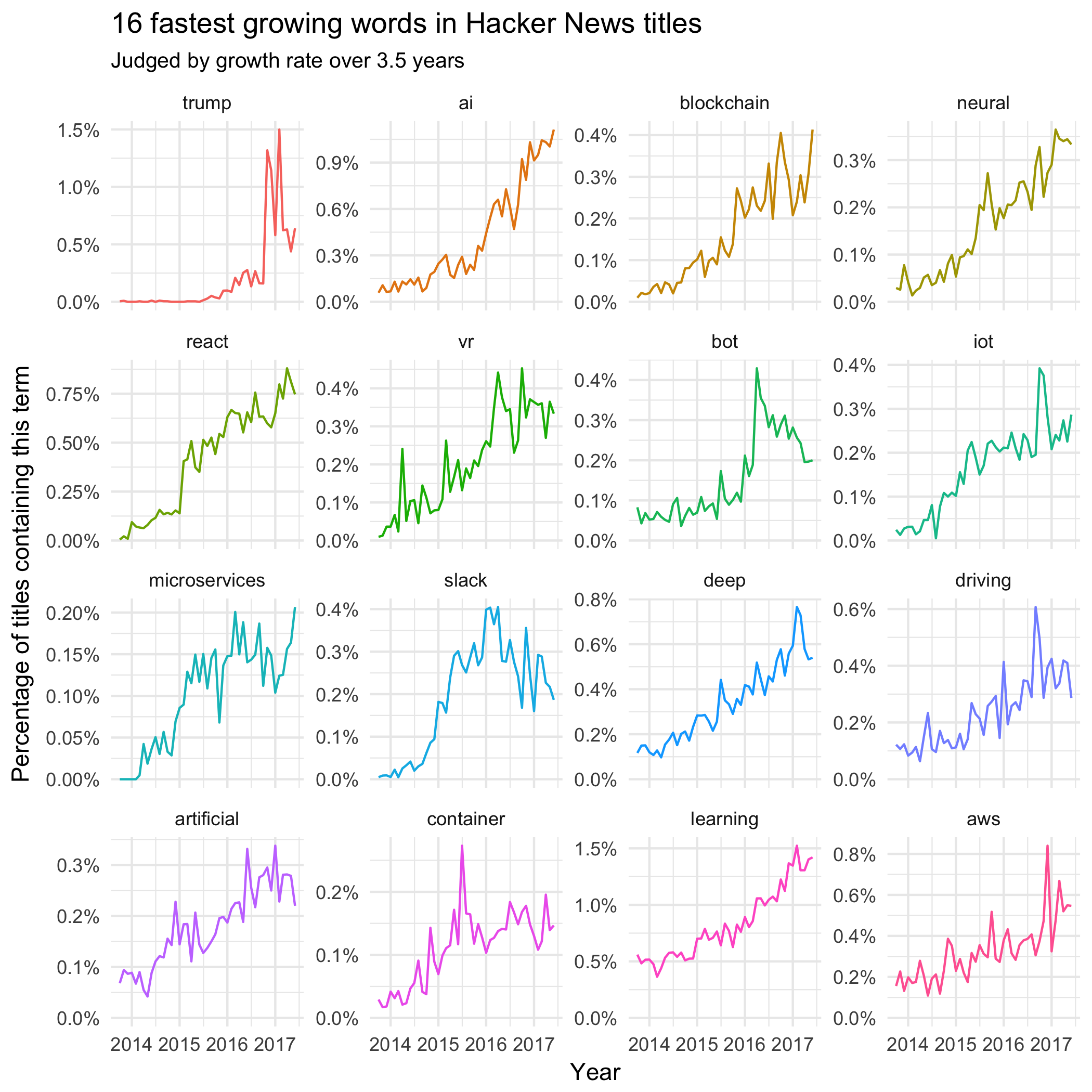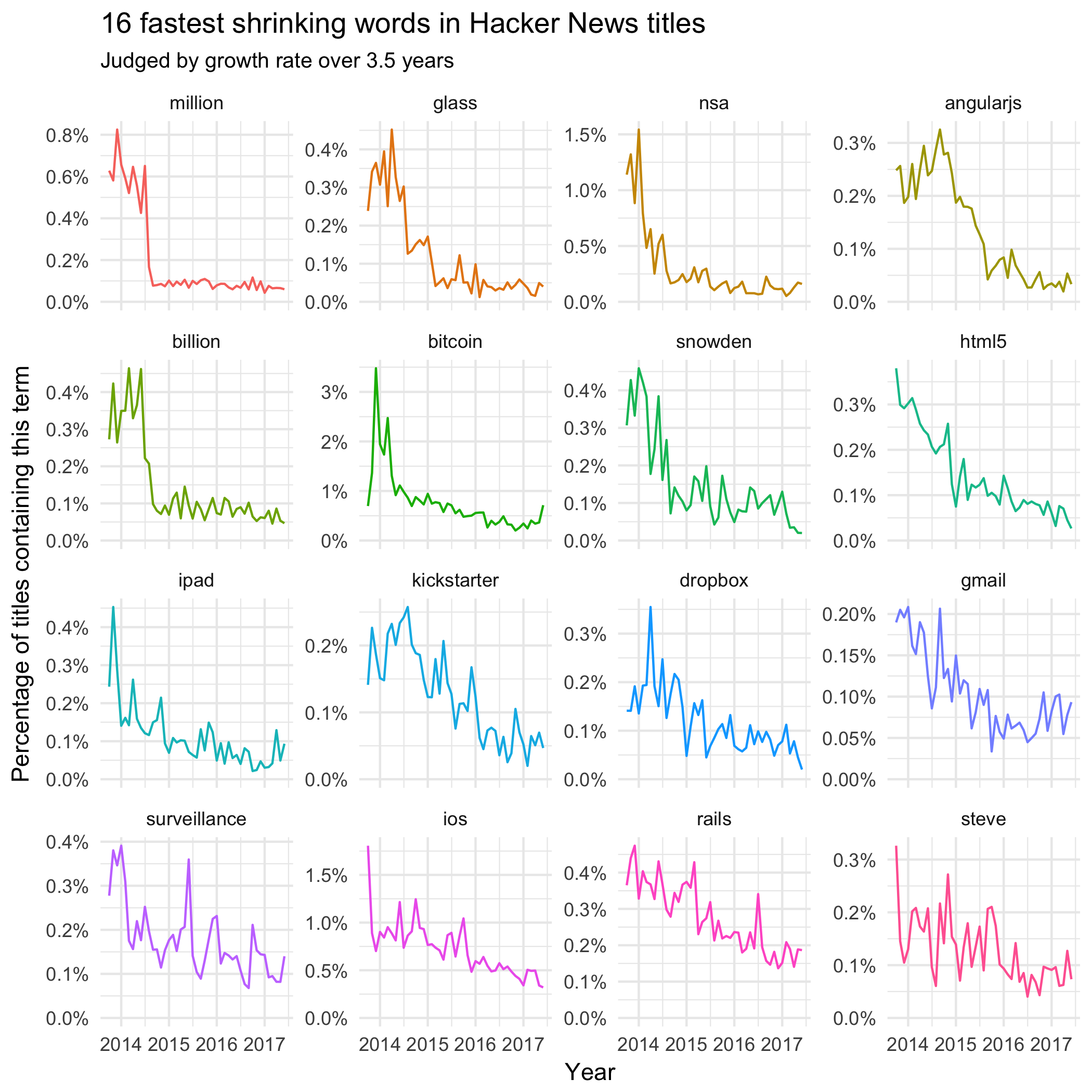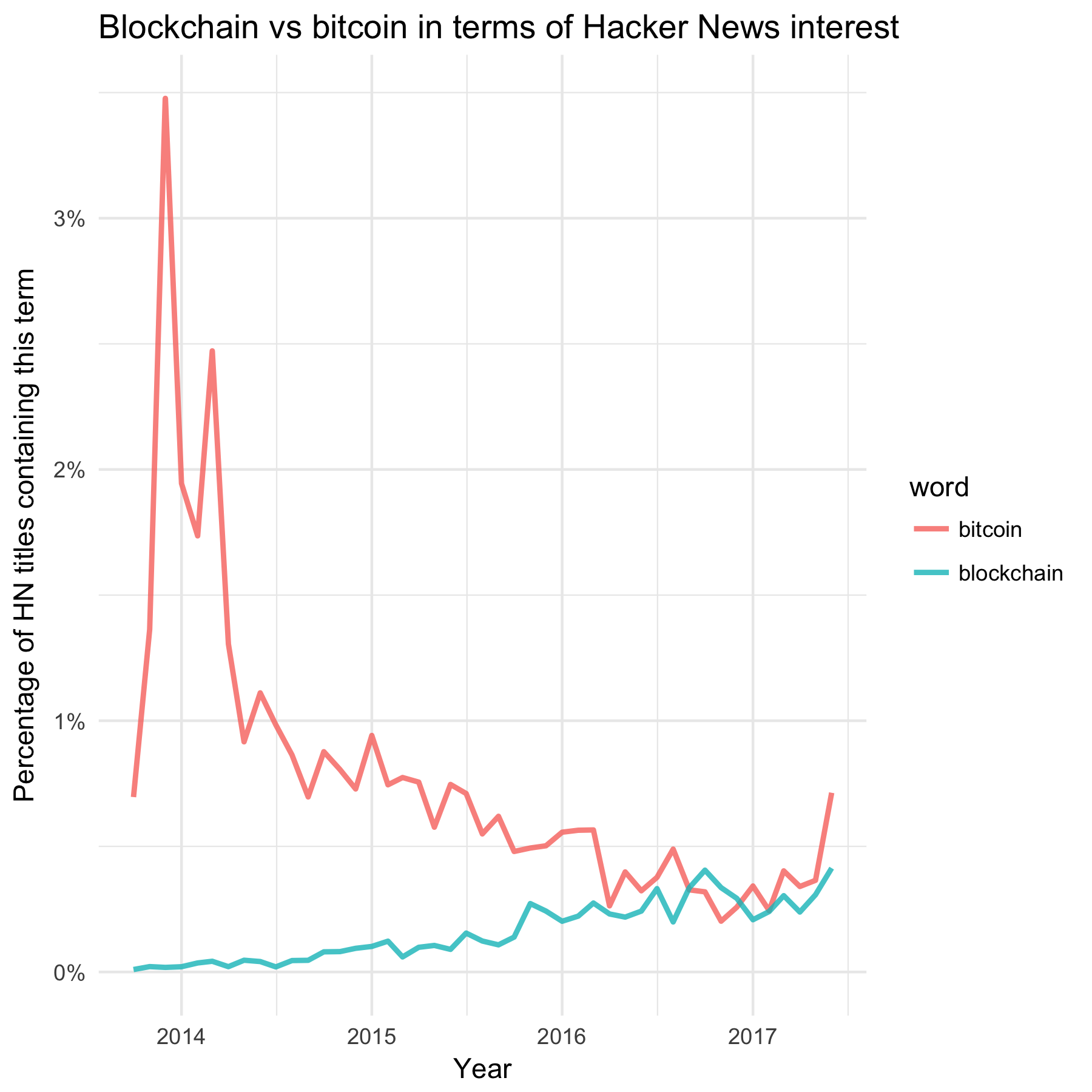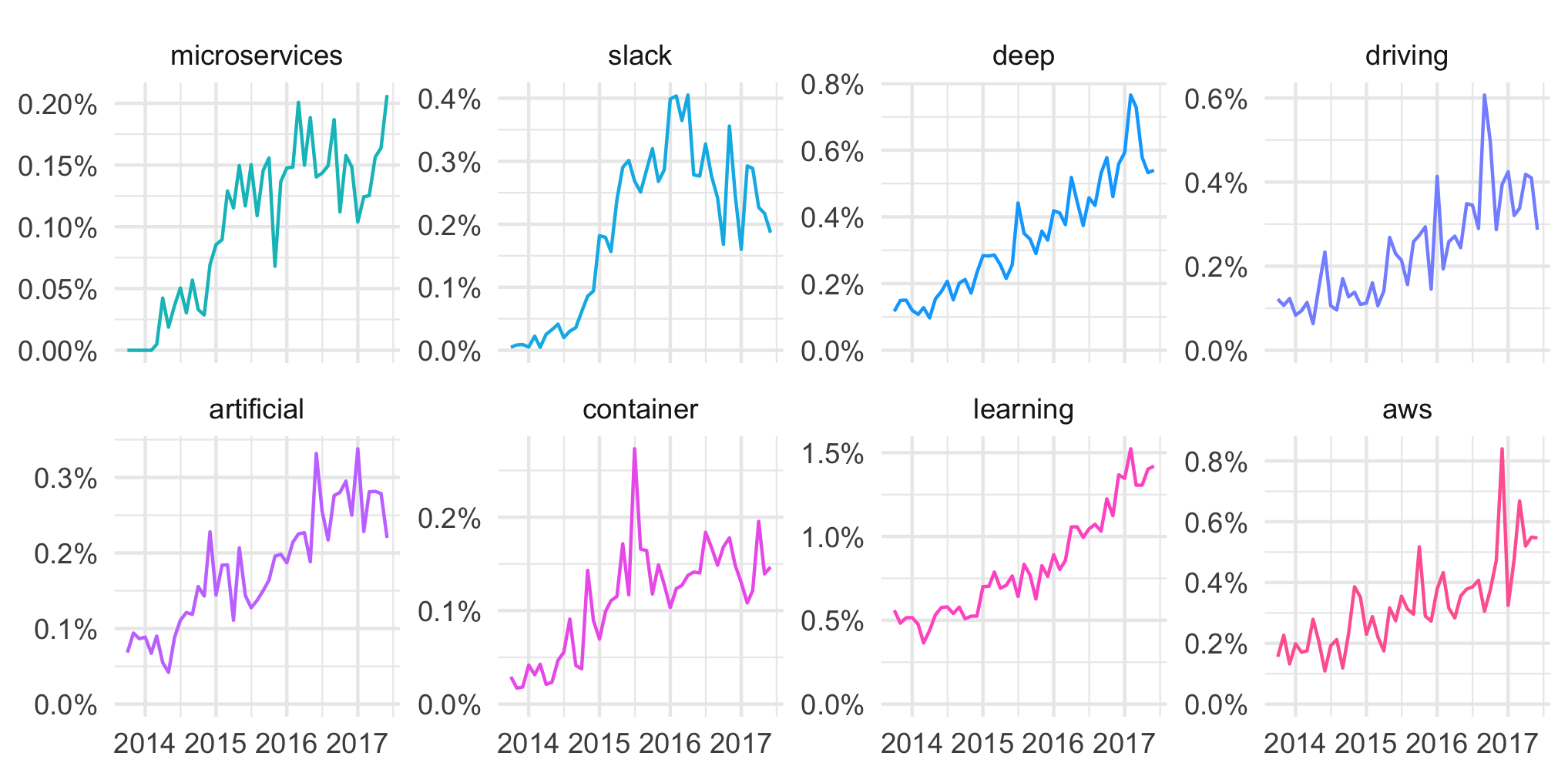While Y Combinator has made a clear impact on the tech sector, the company also launched an internal side project in 2007 that would end up becoming highly influential in a different and surprising way. Its user-powered news aggregator called Hacker News, which is now visited by 20 million people per month, has become a mainstay for entrepreneurs, tech professionals, and venture capitalists around the world. Using a Reddit-like interface, users can upvote and downvote articles that they think have the most relevance to trends and issues affecting the tech sector.
Data Mining For Trends
Today’s charts come to us from Variance Explained, and they help to paint a picture of what topics have been trending on Hacker News over the last 3.5 years. Using data from over 1 million subject lines, we can see which topics are being mentioned with increasing frequency by the site’s community of technology influencers.
As you can see, words like “AI”, “artificial”, “bot”, “deep”, “neural”, and “learning” are key terms that have growing interest within the community. It shows that the buzz around AI and deep learning is widespread and happening on multiple fronts. Donald Trump was also a hot topic of debate in Hacker News, as evidenced by the increase in mentions.
Cooling Off
Here are some of the words in the community used with decreasing frequency over the same 3.5 year timeframe:
Over time, as the rubber hits the road, we get to see which ideas have staying power. Google Glass, as cool as it was, ended up not directly revolutionizing how we use augmented reality. Likewise, Edward Snowden’s revelations about the NSA and surveillance seemed to have also dropped out of discussion. On the flipside, some of these concepts also seem to have transitioned to the mainstream. Bitcoin and other altcoins, for example, are now more popular than ever before with a market capitalization of over $100 billion. Likewise, iPads, Gmail, and Kickstarter are pretty ubiquitous, but it could be argued that discussion on these topics is now pretty staid for the idea-hungry folks that frequent Hacker News.
Blockchain vs. Bitcoin
It’s also interesting to see the contrasting popularity of two related terms among Hacker News participants. Bitcoin-related talk, at least on Hacker News, was hot in late-2013 after the price skyrocketed for the first time. The blockchain, on the other hand, took some time to pick up steam among influencers.
Fast-forward to today, and the concept of the blockchain is much more fleshed out. It took time, but the blockchain is now considered to be a foundational technology that is affecting everything from how how stock markets work, to the proof of ownership for digital assets.
on But fast forward to the end of last week, and SVB was shuttered by regulators after a panic-induced bank run. So, how exactly did this happen? We dig in below.
Road to a Bank Run
SVB and its customers generally thrived during the low interest rate era, but as rates rose, SVB found itself more exposed to risk than a typical bank. Even so, at the end of 2022, the bank’s balance sheet showed no cause for alarm.
As well, the bank was viewed positively in a number of places. Most Wall Street analyst ratings were overwhelmingly positive on the bank’s stock, and Forbes had just added the bank to its Financial All-Stars list. Outward signs of trouble emerged on Wednesday, March 8th, when SVB surprised investors with news that the bank needed to raise more than $2 billion to shore up its balance sheet. The reaction from prominent venture capitalists was not positive, with Coatue Management, Union Square Ventures, and Peter Thiel’s Founders Fund moving to limit exposure to the 40-year-old bank. The influence of these firms is believed to have added fuel to the fire, and a bank run ensued. Also influencing decision making was the fact that SVB had the highest percentage of uninsured domestic deposits of all big banks. These totaled nearly $152 billion, or about 97% of all deposits. By the end of the day, customers had tried to withdraw $42 billion in deposits.
What Triggered the SVB Collapse?
While the collapse of SVB took place over the course of 44 hours, its roots trace back to the early pandemic years. In 2021, U.S. venture capital-backed companies raised a record $330 billion—double the amount seen in 2020. At the time, interest rates were at rock-bottom levels to help buoy the economy. Matt Levine sums up the situation well: “When interest rates are low everywhere, a dollar in 20 years is about as good as a dollar today, so a startup whose business model is “we will lose money for a decade building artificial intelligence, and then rake in lots of money in the far future” sounds pretty good. When interest rates are higher, a dollar today is better than a dollar tomorrow, so investors want cash flows. When interest rates were low for a long time, and suddenly become high, all the money that was rushing to your customers is suddenly cut off.” Source: Pitchbook Why is this important? During this time, SVB received billions of dollars from these venture-backed clients. In one year alone, their deposits increased 100%. They took these funds and invested them in longer-term bonds. As a result, this created a dangerous trap as the company expected rates would remain low. During this time, SVB invested in bonds at the top of the market. As interest rates rose higher and bond prices declined, SVB started taking major losses on their long-term bond holdings.
Losses Fueling a Liquidity Crunch
When SVB reported its fourth quarter results in early 2023, Moody’s Investor Service, a credit rating agency took notice. In early March, it said that SVB was at high risk for a downgrade due to its significant unrealized losses. In response, SVB looked to sell $2 billion of its investments at a loss to help boost liquidity for its struggling balance sheet. Soon, more hedge funds and venture investors realized SVB could be on thin ice. Depositors withdrew funds in droves, spurring a liquidity squeeze and prompting California regulators and the FDIC to step in and shut down the bank.
What Happens Now?
While much of SVB’s activity was focused on the tech sector, the bank’s shocking collapse has rattled a financial sector that is already on edge.
The four biggest U.S. banks lost a combined $52 billion the day before the SVB collapse. On Friday, other banking stocks saw double-digit drops, including Signature Bank (-23%), First Republic (-15%), and Silvergate Capital (-11%).
Source: Morningstar Direct. *Represents March 9 data, trading halted on March 10.
When the dust settles, it’s hard to predict the ripple effects that will emerge from this dramatic event. For investors, the Secretary of the Treasury Janet Yellen announced confidence in the banking system remaining resilient, noting that regulators have the proper tools in response to the issue.
But others have seen trouble brewing as far back as 2020 (or earlier) when commercial banking assets were skyrocketing and banks were buying bonds when rates were low.



















